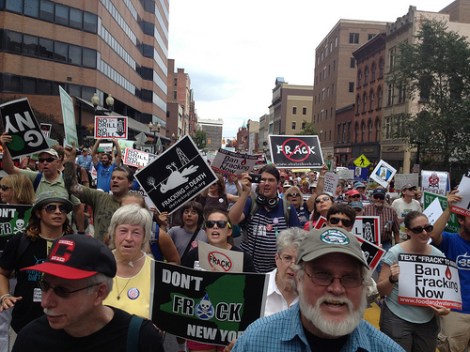How much methane leaks out of the ground during the fracking process? There’s a long-running debate over that question, and the answer could determine the role of natural gas in a climate-changed world. Natural gas burns more cleanly than coal and oil, but that benefit could be outweighed if fracking causes significant releases of methane, a greenhouse gas that is orders of magnitude more effective at trapping heat than carbon dioxide.
Last year, researchers from Cornell reported that fracked natural-gas wells leak 40 to 60 percent more methane than conventional natural-gas wells — making fracking a more dangerous source of greenhouse gas emissions than coal.
But today, a team from MIT suggested the Cornell report may be incorrect — that fracking doesn’t result in much more methane emission than standard natural-gas drilling.
From E&E News:
[A]bout 216 gigagrams of methane [emitted] in 2010 … was due to hydraulic fracturing, a technique in which drillers inject pressurized water, sand and chemicals to fracture shale rock and release trapped gas. Fracking accounted for 3.6 percent of the 6,002 gigagrams of methane emitted overall by natural gas operations in 2010.
The implication is that shale gas drilling operations leak most of their methane from much of the same points as conventional gas drilling operations: pipelines, compressor stations, valves and other point sources. These account for about 96.4 percent of the emissions from a gas production site, the study finds.
There are a few caveats. The first is that the methodology for the calculations is based on different assumptions than those used by the EPA.
Depending on who is asked, companies either almost completely capture or flare their methane during completions, or almost completely vent the gas to the atmosphere. U.S. EPA assumes that half the gas is flared and half is vented.
In the MIT study, the authors assume that 70 percent is captured, 15 percent is flared and 15 percent is vented. They term this “current field practice” and say it is based on “extensive discussions with industry, EPA and other relevant groups regarding actual field practice.”
If those assumptions are off, it means that the study’s calculations on methane release are also incorrect. But we’ll defer to MIT.
Another caveat: It’s difficult to tell from this study how much more methane is released from fracked wells than traditional wells. The Energy Information Administration doesn’t have data for 2010, oddly, so it’s hard to compare. (The MIT study itself [PDF] doesn’t seem to have that data either.)
And the third (and most important) caveat: MIT’s research suggests that 3.1 percent of the nation’s entire 2010 greenhouse gas output in 2010 came from leaks in the natural gas production and distribution chain. Reducing that massive waste — some 10,259 gigagrams — could do much more to reduce warming than banning fracking. (We could start in Boston.)
It seems safe to assume that this research is not the final word on emissions related to fracking. But it can actually be considered good news: The negative effects of a controversial process may be lower than thought.




